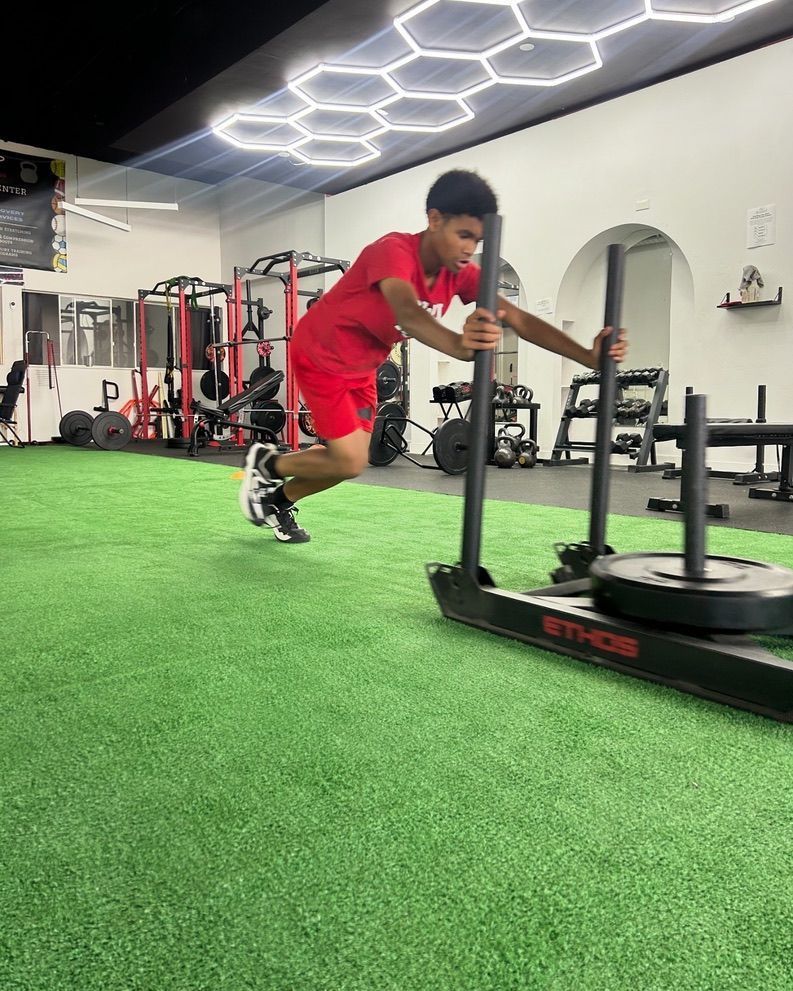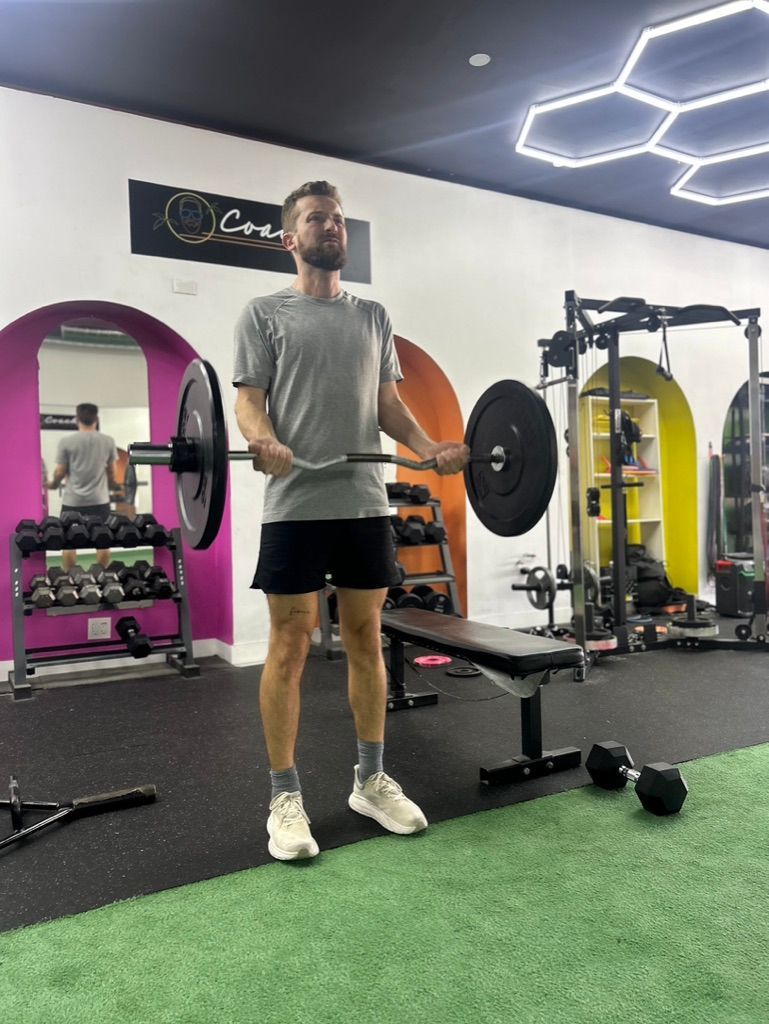The Power of Speed Training: Why Every Young Athlete Should Start Now
Brandon Wolucka • August 28, 2025
Speed Training: More Benefits than you think
When we think of elite athletes—those who jump higher, throw farther, and blow past defenders—speed is almost always a key part of their performance. Whether you're sprinting down the field, launching off the ground for a rebound, or exploding out of the blocks, speed is what separates the good from the great.
But speed isn’t just something you’re born with—it can be developed. And the earlier athletes start speed training, the greater the long-term benefits.
Here’s why speed training should be a cornerstone of every youth athlete’s development:
💥 1. Builds Fast-Twitch Muscle for Explosive Performance
Speed training targets fast-twitch muscle fibers—the ones responsible for quick, powerful movements. These fibers are what help athletes jump higher, throw faster, and hit harder. By repeatedly activating these muscles through high-speed drills, athletes teach their bodies to respond faster and with more force, leading to noticeable improvements in all power-based movements.
🔁 2. The Only Fast-Twitch Training You Can Do in High Volume
Unlike heavy lifting or plyometrics, sprinting and speed drills allow for high-volume, repetitive training without excessive wear and tear. That means athletes can consistently build speed and power over time without the same injury risk, making it one of the safest ways to train explosiveness frequently.
🧠 3. Early Start = Better Coordination
Speed training improves more than just physical performance—it enhances neuromuscular coordination. For younger athletes, this is critical. Early exposure to sprint mechanics and fast movement patterns develops better balance, body control, and movement efficiency, laying a strong foundation for long-term athletic success.
💪 4. Increases Strength and Elasticity
Sprinting isn’t just about moving fast—it's a full-body strength workout. It builds glute, hamstring, core, and calf strength naturally. It also improves muscle and tendon elasticity, which helps reduce injury risk and increases an athlete’s ability to store and release energy, like a spring.
🚀 5. Focused Speed Work Beats Conditioning
Too often, athletes treat sprints as conditioning. But true speed development needs a dedicated training phase—not tacked on to the end of practice. Whether it's working on the drive phase, acceleration mechanics, or top-end speed, this focus allows athletes to make real improvements without diluting the purpose with fatigue.
⛓️ 6. Resisted Sprinting for Power Output
Speed training should include resisted sprints to build force production. This can include:
- Sled sprints
- Band-resisted or pulley system drills
- Hill sprints
These methods help athletes push harder through the ground, increasing power and improving acceleration mechanics.
⚡ 7. Max Velocity Work = Game-Changing Speed
To run faster, athletes must train at full speed. Top-end speed work—running at max velocity over 20–40 meters—teaches athletes how to maintain posture, stride length, and frequency. This is where real speed is developed, not in half-effort drills or "gassers."
Final Thoughts
Speed is a skill, and like any skill, it must be practiced with purpose and consistency. By incorporating smart, structured speed training into an athlete's routine—especially at a young age—you’re building a stronger, faster, more explosive athlete from the ground up.
Whether your goal is to outpace the competition or simply become a more dynamic player, speed training is the missing piece that turns potential into performance.
Ready to get faster?
Start training smart. Train fast. Train with intent.
Let speed be your edge.


When most people think of strength training, they imagine bulging muscles, heavy barbells, and grueling gym sessions. But the truth is, strength training is one of the most effective and accessible forms of exercise for everyone—regardless of age, gender, or fitness level. Whether you're a beginner or a seasoned athlete, incorporating strength training into your routine can lead to profound improvements in your health, well-being, and quality of life. What Is Strength Training? Strength training (also known as resistance training or weight training) involves using resistance—such as free weights, resistance bands, or even your own body weight—to build muscle strength, endurance, and size. This can include exercises like squats, push-ups, deadlifts, and resistance band workouts. Now, let’s break down the many science-backed benefits of strength training, including how it boosts performance and helps athletes stay on the field longer. 1. Builds Muscle Mass and Strength Strength training helps increase muscle size and strength, which improves your ability to perform everyday tasks and physical activities. For athletes, stronger muscles mean enhanced performance in virtually every sport—faster sprints, higher jumps, and more powerful throws. 2. Enhances Athletic Performance Athletes across all sports benefit from strength training. It improves: Speed and power: Exercises like squats and Olympic lifts train explosive strength, crucial for sprinting and jumping. Agility and coordination: Strength work enhances neuromuscular control, helping athletes change direction quickly and with precision. Sport-specific endurance: Targeted training improves muscular stamina for longer-lasting performance on the field, court, or track. Strength training can be tailored to the specific movement patterns, energy systems, and physical demands of each sport—making it a key tool in any athlete’s training plan. 3. Reduces Risk of Injury One of the most important but overlooked benefits of strength training is injury prevention. Strong muscles, tendons, and ligaments provide better joint stability and shock absorption. This helps prevent common injuries like ACL tears, hamstring strains, and shoulder issues . For example: Strengthening the glutes and hamstrings can protect against knee injuries. Improving core strength supports better posture and spinal alignment, reducing neck and back pain. Trained tissues will recover from soft tissue injuries than untrained tissues. Meaning if you strain a muscle or roll an ankle, it will recover faster if the muscles are stronger. Studies show that athletes who include resistance training in their routine have significantly lower injury rates compared to those who don't. 4. Boosts Metabolism and Aids in Fat Loss Muscle is metabolically active tissue, meaning it burns more calories than fat —even at rest. Strength training helps increase your resting metabolic rate, making it easier to manage body composition, which is especially important for athletes looking to optimize performance weight. 5. Improves Bone Health and Joint Function Strength training is one of the best ways to improve bone density and prevent osteoporosis. Stronger bones and joints are critical for long-term athletic development and healthy aging. 6. Enhances Mental Toughness and Focus Training with resistance doesn't just strengthen your body—it sharpens your mind. Regular strength training can improve mood, decrease anxiety and depression , and build the mental discipline required to push through challenges—on and off the field. 7. Better Posture, Balance, and Mobility Strength training improves postural alignment and balance by targeting the stabilizing muscles in your core, shoulders and lower body. Most of us spend too much time hunched over a computer, texting, driving or sleeping on your side ; all things that ruin our posture.This is crucial not only for daily life but also for athletic performance, where balance and control can be the difference between winning and injury. 8. Adaptable and Time-Efficient You don’t need to spend hours in the gym to see results. With a well-designed program, you can build strength and see significant improvements in as little as 2–3 sessions per week. Whether you train at home, at a gym, or in a sports facility, strength training can be adapted to suit your lifestyle and goals. Final Thoughts Strength training is a powerhouse tool that does far more than sculpt muscles. From everyday strength and metabolic health to enhanced athletic performance and reduced injury risk for people of all ages, the benefits are wide-reaching and well-supported by science. If you're an athlete, it could be your secret weapon. If you're just starting out, it's your foundation for a stronger, healthier life. So don’t just lift for the mirror—lift for your future. Your body (and your performance) will thank you!!



Share On: